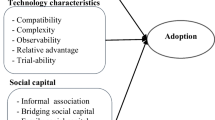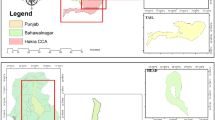Abstract
Water constraints are becoming a major restriction for different economic sectors. The agricultural sector is one of the most affected, but according to experts, the use of irrigation technologies and scheduling can keep productivity high while diminishing the use of water resources. Although irrigation technology is available, for various reasons the rate of adoption is rather low. This article uses a recursive bivariate probit model to examine the impact of social, human, and physical capital on the adoption of irrigation technology and scheduling. The study was conducted in vineyard farms in the Maule and O’Higgins regions of Chile, from which a sample of 452 large, medium, and smallholders was drawn. The average planted area is 37 hectares, ranging from 0.5 to 810 hectares. The adoption rate of irrigation technology is 43 % and for scheduling instruments, 23 %. Results show that adopting irrigation technology increases the chance of adopting scheduling by 31 % and that these adoption decisions are jointly made. While size of the vineyard is relevant in irrigation technology adoption, it is not for scheduling and, in contrast, the use of the Internet is relevant for adopting scheduling but not for irrigation technology. A relevant result is that networks and trust are important factors in explaining the adoption of both technologies.
Similar content being viewed by others
Notes
The Maule region is located in Central-South Chile (35 ∘ 25\(^{\prime }\)36\(^{\prime \prime }\)S, 71 ∘ 39\(^{\prime }\)78\(^{\prime \prime }\)O), and its main agricultural activity is fruit and vineyard production.
Patricio González, Assistant Professor at University of Talca, personal communication.
Instruments include metrological stations, soil or plant sensors, and pan evaporation.
The municipalities were, in order of number of surveyed producers: San Javier, Sagrada Familia, Curicó, Nancagua, Villa Alegre, Santa Cruz, Talca, Palmilla, San Clemente, Peralillo, Río Claro, Requinoa, Chimarongo, Maule, San Vicente, and Peumo.
References
Abdulai A, Huffman W (2014) The Adoption and Impact of Soil and Water Conservation Technology: An Endogenous Switching Regression Application. Land Econ 90(1):26–43. Available at doi:http://le.uwpress.org/cgi/doi/10.3368/le.90.1.26
Abdulai A, Owusu V, Bakang J-EA (2011) Adoption of safer irrigation technologies and cropping patterns: Evidence from Southern Ghana. Ecol Econ 70 (7):1415–1423. Available at http:/linkinghub.elsevier.comretrievepiiS0921800911000930
Acevedo-Opazo C, Ortega-Farias S, Fuentes S (2010) Effects of grapevine (Vitis viniferaL.) water status on water consumption, vegetative growth and grape quality: An irrigation scheduling application to achieve regulated deficit irrigation. Agric Water Manag 97(7):956–964. Available at http:/linkinghub.elsevier.comretrievepiiS0378377410000430
Adesina AA, Zinnah MM (1993) Technology characteristics, farmers’ perceptions and adoption decisions: A Tobit model application in Sierra Leone. Agric Econ 9 (4):297–311. Available at: doi:10.10160169-5150(93)90019-9
Alam A et al (2012) Stochastic frontier approach to measure technical efficiency of two irrigation systems in Gilgit district, Gilgit-Baltistan region of Pakistan. Journal of Food 10(1):543–550. Available at: http://world-food.net/download/journals/2012-issue_1/a71.pdf
Alcon F, de Miguel MD, Burton M (2011) Duration analysis of adoption of drip irrigation technology in southeastern Spain. Technol Forecast Soc Chang 78 (6):991–1001. Available at http:/linkinghub.elsevier.comretrievepiiS0040162511000278
Anley Y, Bogale A, Haile-Gabriel A (2007) Adoption decision and use intensity of soil and water conservation measures by smallholder subsistence farmers in Dedo District, Western Ethiopia. Land Degrad Dev 18(3):289–302. Available at doi:http://doi.wiley.com/10.1002ldr.775
Bandiera O, Rasul I (2006) Social networks and technology adoption in northern mozambique*. Econ J 116(514):869–902. Available at http:/eprints.ucl.ac.uk12669
Beugelsdijk S, Smulders S (2004) Social capital and economic growth. Tilburg University. Available at http:/down.cenet.org.cnupfile51200591785152126.pdf
Bhatti GH, Patel HM (2015) Irrigation scheduling strategies for cotton crop in semi-arid climate using WEAP model. Journal of Indian Water Resources Society. Available at http:/iwrs.org.injournaljan20153jan.pdf
Bjornlund H, Nicol L, Klein KK (2009) The adoption of improved irrigation technology and management practices:A study of two irrigation districts in Alberta, Canada. Agric Water Manag 96(1):121–131. Available at http:/linkinghub.elsevier.comretrievepiiS0378377408001753
Bolino MC, Turnley WH, Bloodgood JM (2002) Citizenship behavior and the creation of social capital in organizations. Acad Manag Rev 27(4):505–522. Available at doi:http://amr.aom.org/cgi/doi/10.5465/AMR.2002.7566023
Bouma J, Bulte E, van Soest D (2008) Trust and cooperation: Social capital and community resource management. Econ Manag 56(2):155–166. Available at http:/linkinghub.elsevier.comretrievepiiS0095069608000521
Castello JV (2012) Promoting employment of disabled women in Spain; Evaluating a policy. Labour Econ 19(1):82–91. Available at http:/linkinghub.elsevier.comretrievepiiS092753711100087X
Chalupnicek P (2010) The CAPITAL in Social Capital: An Austrian Perspective. Am J Econ Sociol 69(4):1230–1250. Available at doi:http://doi.wiley.com/10.1111/j.1536-7150.2010.00742.x
Chandran KM, Joseph EJ (2015) Innovativeness of Farmers in Irrigation Scheduling for Major Plantation Crops: Analysis from Kerala State, India. J Agric Sci 10(2):131. Available at http://jas.sljol.info/article/10.4038/jas.v10i2.8058/
Chartzoulakis K, Bertaki M (2015) Sustainable Water Management in Agriculture under Climate Change. Agric Agric Sci Procedia 4:88–98. Available at http:/linkinghub.elsevier.comretrievepiiS2210784315000741
Chilean Ministry of Agriculture (2013) Plan de adaptación al cambio climático del sector silvoagropecuario. mma.gob.cl. Available at: http://www.mma.gob.cl/1304/articles-52367_PlanAdpatacionCCS.pdf
CIREN (2011) Determinación de erosión actual y potencial para el territorio de Chile. pp.1–31
CIREN (2010) Determinación de Erosion Potencial y Actual de Chile. pp.1–145
Cramb RA, Purcell T, Ho TCS (2004) Participatory assessment of rural livelihoods in the Central Highlands of Vietnam. Agric Syst 81(3):255–272. Available at http:/linkinghub.elsevier.comretrievepiiS0308521X03002014
Dry PR, Loveys BR (1998) Factors influencing grapevine vigour and the potential for control with partial rootzone drying. Aust J Grape Wine Res 4(3):140–148. Available at doi:http://doi.wiley.com/10.1111/j.1755-0238.1998.tb00143.x
Eastwood CR, Chapman DF, Paine MS (2012) Networks of practice for co-construction of agricultural decision support systems: Case studies of precision dairy farms in Australia. Agric Syst 108:10–18. Available at doi:10.1016/j.agsy.2011.12.005
El Chami D, Karaa K (2012) New legislation for Water User Associations (WUA): Increasing sustainability in irrigation project implementation in Lebanon. Water Utility Journal 4:33–38
Ezzhaouani A, Valancogne C, Pieri P (2007) Water economy by Italia grapevines under different irrigation treatments in a Mediterranean climate. des Sciences de la 41(3):131–139. Available at: http:/viticulture.ucdavis.edupdfattachment163irrigationandItaliagrapesinMorocco.pdf
Di Falco S, Van Rensburg TM (2008) Making the commons work: Conservation and cooperation in Ireland. Land Econ 84(4):620–634. Available at doi:http://le.uwpress.org/cgi/doi/10.3368/le.84.4.620
Foster AD, Rosenzweig MR (2010) Microeconomics of technology adoption. Annu Rev Econ 2:395–424. Available at http:/www.ncbi.nlm.nih.govpmcarticlesPMC3876794
Frisvold GB, Deva S (2012) Farm size, irrigation practices, and conservation program participation in the US Southwest. Irrig Drain 61(5):569–582. Available at doi:http:/onlinelibrary.wiley.com/doi.10.1002ird.1676full
Frondel M, Horbach J, Rennings K (2008) What triggers environmental management and innovation? Empirical evidence for Germany. Ecol Econ 66(1):153–160. Available at http:/www.sciencedirect.comsciencearticlepiiS0921800907004429
Genius M et al (2014) Information Transmission in Irrigation Technology Adoption and Diffusion: Social Learning, Extension Services, and Spatial Effects. Am J Agric Econ 96(1):328–344. Available at doi:http://ajae.oxfordjournals.org/cgi/doi/10.1093/ajae/aat054
Greene WH (2003) Econometric analysis. Available at: http:/link.springer.com/10.1007978-3-540-24728-9
Handschuch C, Wollni M, Villalobos P (2013) Adoption of food safety and quality standards among Chilean raspberry producers-Do smallholders benefit? Food Policy 40:64–73. Available at http:/linkinghub.elsevier.comretrievepiiS0306919213000195
Hess TM, Knox JW (2013) Water savings in irrigated agriculture: A framework for assessing technology and management options to reduce water losses. Outlook on Agriculture 42(2):85–91. Available at: http://www.scopus.com/inward/record.url?partnerID=HzOxMe3b&scp=84880630068&origin=inward
Heumesser C et al (2012) Investment in Irrigation Systems under Precipitation Uncertainty. Water Resour Manag 26(11):3113–3137. Available at http://link.springer.com/10.1007s11269-012-0053-x
Jara-Rojas R et al (in press) Adoption of irrigation scheduling: Role of extension and training in central Chile. Enrironmental Engineering and Management Journal
Jara-Rojas R et al (2013) An analysis of the joint adoption of water conservation and soil conservation in Central Chile. Land Use Policy 32:292–301. Available at http:/linkinghub.elsevier.comretrievepiiS0264837712002116
Kaasa A (2009) Effects of different dimensions of social capital on innovative activity: Evidence from Europe at the regional level. Technovation 29(3):218–233. Available at http:/linkinghub.elsevier.comretrievepiiS0166497208000138
Liu S et al (2010) Crop yield responses to climate change in the Huang-Huai-Hai Plain of China. Agric Water Manag 97(8):1195–1209. Available at http:/linkinghub.elsevier.comretrievepiiS0378377410000983
Lollo E (2012) Toward a theory of social capital definition: its dimensions and resulting social capital types. 14th World Congress of Social Economics. Available at: http:/socialeconomics.orgPapersLollo1C.pdf
Montoro A, López-Fuster P, Fereres E (2011) Improving on-farm water management through an irrigation scheduling service. Irrigation Science. Available at http://link.springer.com/article/10.1007/s00271-010-0235-3
Namara RE, Nagar RK, Upadhyay B (2007) Economics, adoption determinants, and impacts of micro-irrigation technologies: empirical results from India. Irrig Sci 25 (3):283–297. Available at http:/link.springer.com/10.1007s00271-007-0065-0
Naor A (2006) Irrigation scheduling and evaluation of tree water status in deciduous orchards. Horticultural reviews-westport then new. Available at: https://www.researchgate.net/profile/Amos_Naor/publication/228054880_Irrigation_Scheduling_and_Evaluation_of_Tree_Water_Status_in_Deciduous_Orchards/links/0fcfd50e67c6830cd1000000.pdf
ODEPA (2012) CATASTRO VITICOLA NACIONAL 2012. pp.1–56. Available at: http:/www.odepa.clwp-contentuploads201305catastro2012-final.pdf
Ojeda H, Deloire A, Carbonneau A (2015) Influence of water deficits on grape berry growth. VITIS-Journal of Grapevine. Available at http:/pub.jki.bund.deindex.phpVITISarticleview4512
Pellegrino A (2005) Towards a simple indicator of water stress in grapevine (Vitis vinifera L.) based on the differential sensitivities of vegetative growth components. Aust J Grape Wine Res 11(3):306–315. Available at doi:http://doi.wiley.com/10.1111/j.1755-0238.2005.tb00030.x
Rahm MR, Huffman WE (1986) The Adoption of Reduced Tillage - the Role of Human-Capital and Other Variables - Reply. Am J Agric Econ 68(1):184. Available at doi:http://ajae.oxfordjournals.org/cgi/doi/10.2307/1241669
Ramirez A (2013) The Influence of Social Networks on Agricultural Technology Adoption. Procedia - Social and Behavioral Sciences 79:101–116. Available at http:/linkinghub.elsevier.comretrievepiiS1877042813010288
Ríos Brehm M., Quiroz J. (1995) The market of water rights in Chile: major issues. Cuadernos de Economía 32:317–345
Roco L et al (2014) Farmers’ perception of climate change in mediterranean Chile. Reg Environ Chang 15(5):867–879. Available at http://link.springer.com/10.1007/s10113-014-0669-x
Schuck EC et al (2005) Adoption of More Technically Efficient Irrigation Systems as a Drought Response. Int J Water Resour Dev 21(4):651–662. Available at doi:http://www.tandfonline.com/doi/abs/10.108007900620500363321
Solano C et al (2003) The role of personal information sources on the decision-making process of Costa Rican dairy farmers. Agricultural Systems. Available at: http://www.sciencedirect.com/science/article/pii/S0308521X02000744
Taragola NM, Van Lierde DF (2010) Factors affecting the Internet behaviour of horticultural growers in Flanders, Belgium. Comput Electron Agric 70 (2):369–379. Available at http://pubget.com/site/paper/1de41df3-652e-460c-8f20-b0b290b623f6?institution=
Thuo M et al (2014) Effects of social network factors on information acquisition and adoption of improved groundnut varieties: the case of Uganda and Kenya. Agric Hum Values 31(3):339–353. Available at http://link.springer.com/10.1007/s10460-014-9486-6
van Rijn F, Bulte E, Adekunle A (2012) Social capital and agricultural innovation in Sub-Saharan Africa. Agric Syst 108:112–122. Available at http:/linkinghub.elsevier.comretrievepiiS0308521X11001818
Author information
Authors and Affiliations
Corresponding author
Appendices
Appendix A: Description of trust variables
A factor analysis was performed to obtain the components of social capital. To elicit the components, we used a list of statements that the farmers rated according to a Likert scale from 1 to 5. Five components were elicited as listed below:
-
Component 1:
Networks
-
Component 2:
Trust in Institutions
-
Component 3:
Trust in Water Communities
-
Component 4:
Trust in General
-
Component 5:
Norms
In the model we use the component Trust in General since it covers a wider range of statements that, according to Solano et al 2003; Eastwood et al. 2012, are more relevant in determining adoption. Table A.1 present the results for this specific component.
Appendix B: Geographical characterization of the Cachapoal-Colchagua, Curicó and Maule valleys
Rights and permissions
About this article
Cite this article
Engler, A., Jara-Rojas, R. & Bopp, C. Efficient use of Water Resources in Vineyards: A Recursive joint Estimation for the Adoption of Irrigation Technology and Scheduling. Water Resour Manage 30, 5369–5383 (2016). https://doi.org/10.1007/s11269-016-1493-5
Received:
Accepted:
Published:
Issue Date:
DOI: https://doi.org/10.1007/s11269-016-1493-5




